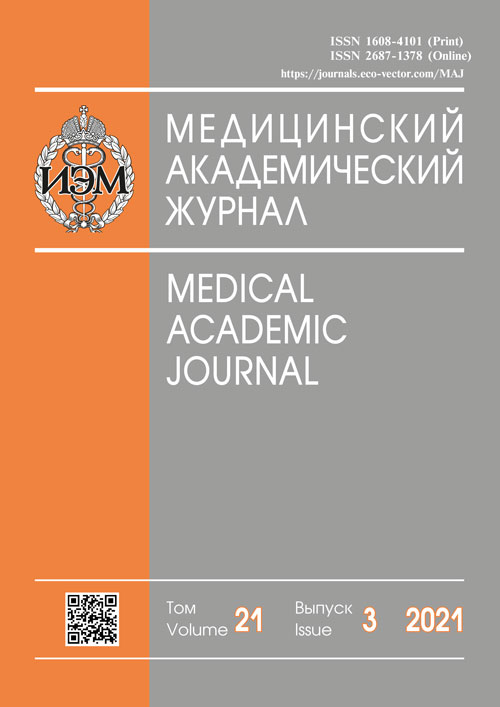Особенности течения вирус-ассоциированного острого повреждения легких у мышей с индуцированной иммуносупрессией
- Авторы: Александров А.Г.1
-
Учреждения:
- Научно исследовательский институт гриппа им. А.А. Смородинцева
- Выпуск: Том 21, № 3 (2021)
- Страницы: 75-80
- Раздел: Материалы конференции
- Статья опубликована: 06.12.2021
- URL: https://journals.eco-vector.com/MAJ/article/view/77325
- DOI: https://doi.org/10.17816/MAJ77325
- ID: 77325
Цитировать
Полный текст
Аннотация
Обоснование. Среди всех групп пациентов с вирус-ассоциированным острым повреждением легких при гриппозной инфекции наиболее тяжелое течение отмечают у пациентов с иммуносупрессией. При этом, несмотря на изученный механизм течения сочетанной патологии, вопрос о применении терапии у данной группы пациентов остается актуальным.
Цель — изучить особенность течения острого повреждения легких при гриппозной инфекции со вторичной иммуносупрессией в эксперименте для последующей оценки возможности поиска экспериментальной терапии данной сочетанной патологии
Материалы и методы. Эксперименты выполнены на 115 аутбредных мышах-самках. Вирус-ассоциированное острое повреждение легких моделировали с помощью материала, содержащего вирус гриппа A/California/7/09МА (mouse-adapted) (H1N1) pdm09. Экспериментальную иммуносупрессию воспроизводили путем введения метотрексата (в дозе 1,25 мг/кг внутрибрюшинно один раз в 3 дня в течение 3 нед. до инфицирования). Течение патологии оценивали по динамике летальности, уровня сатурации крови, концентрации провоспалительных цитокинов в легких и выраженности повреждения легочной паренхимы.
Результаты. Экспериментальная иммуносупрессия привела к отягощению течения острого повреждения легких у инфицированных животных по таким показателям, как уровень летальности и выраженность повреждения легочной паренхимы. Отмечены изменение динамики величины провоспалительных цитокинов (TNF-á, IL-6, IL-1â) в легких в течение острого повреждения легких и замедленное восстановление функциональной активности легких.
Заключение. Экспериментальная иммуносупрессия способствовала как отягощению течения острого повреждения легких, так и увеличению продолжительности течения патологии. Данные изменения могли быть связаны с нарушением процесса элиминации патогена, а модель сочетанной патологии использована для поиска терапии данных осложнений.
Ключевые слова
Полный текст
Об авторах
Андрей Георгиевич Александров
Научно исследовательский институт гриппа им. А.А. Смородинцева
Автор, ответственный за переписку.
Email: forphchemistry@gmail.com
ORCID iD: 0000-0001-9212-3865
научный сотрудник лаборатории безопасности лекарственных средств
Россия, Санкт-ПетербургСписок литературы
- Кожокару В.И., Лобзин Ю.В., Кожокару Д.И. Интенсивная терапия тяжелых осложнений гриппа // Журнал инфектологии. 2012. Т. 4, № 1. С. 58–64. doi: 10.22625/2072-6732-2012-4-1-58-64
- Suratt B.T., Parsons P.E. Mechanisms of acute lung injury/acute respiratory distress syndrome // Clin. Chest. Med. 2006. Vol. 27, No. 4. P. 579–589. doi: 10.1016/j.ccm.2006.06.005
- Harish M.M., Ruhatiya R.S. Influenza H1N1 infection in immunocompromised host: A concise review // Lung India. 2019. Vol. 36, No. 4. P. 330–336. doi: 10.4103/lungindia.lungindia_464_18
- Cortegiani A., Madotto F., Gregoretti C. et al. Immunocompromised patients with acute respiratory distress syndrome: secondary analysis of the LUNG SAFE database // Crit. Care. 2018. Vol. 22, No. 1. P. 157. doi: 10.1186/s13054-018-2079-9
- Шитов Л.Н. Влияние иммунодепрессантов на численность стафилококков в составе микрофлоры толстой кишки // Современные проблемы науки и образования. 2008. № 1. С. 151–152.
- Matute-Bello G., Downey G., Moore B.B. et al. An official American Thoracic Society workshop report: features and measurements of experimental acute lung injury in animals // Am. J. Respir. Cell. Mol. Biol. 2011. Vol. 44, No. 5. P. 725–738. doi: 10.1165/rcmb.2009-0210ST
- Zheng K., Wu L., He Z. et al. Measurement of the total protein in serum by biuret method with uncertainty evaluation // Measurement. 2017. No. 112. P. 16–21. doi: 10.1016/j.measurement.2017.08.013
- Patel B.V., Wilson M.R., Takata M. Resolution of acute lung injury and inflammation: a translational mouse model // Eur. Respir. J. 2011. Vol. 39, No. 5. P. 1162–1170. doi: 10.1183/09031936.00093911
- Spadaro S., Park M., Turrini C. et al. Biomarkers for acute respiratory distress syndrome and prospects for personalised medicine // J. Inflamm. (Lond). 2019. No. 16. P. 1. doi: 10.1186/s12950-018-0202-y
- Оковитый С.В. Клиническая фармакология иммунодепрессантов // Обзоры по клинической фармакологии и лекарственной терапии. 2003. Т. 2, № 2. С. 2–34.
Дополнительные файлы










